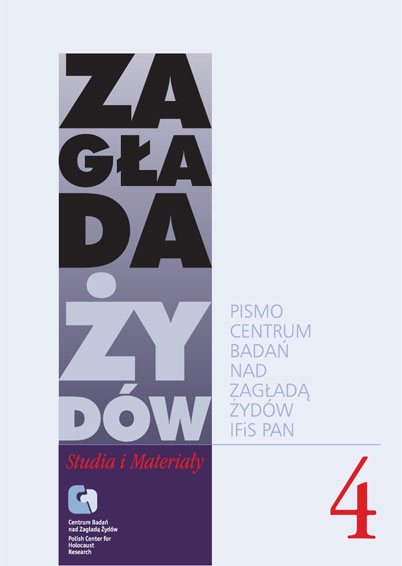An Image Regained
Zagłada Żydów. Studia i Materiały, No. 4 (2008), Pages: 383-402
Submission Date: 2020-12-06Publication Date: 2012-12-02
 https://doi.org/10.32927/zzsim.696
https://doi.org/10.32927/zzsim.696
Abstract
The identification photographs of Auschwitz-Birkenau prisoners are a Holocaust icon. Photography, particularly identification photography, seems especially ambiguous in the context of the Holocaust, and the manner in which it was used and then conceptualized seems especially problematic. The remnants of the postwar photographic practice of former concentration camp prisoners are all the more puzzling: some of them had their photographs taken in concentration camp stripes in professional photo studios. Some dozen photos taken during 1945–1947 show survivors who decided to record their images as ex-prisoners. By doing so they referred to the prewar portrait photography tradition and repeated the gesture of putting on concentration camp outfits and (perhaps) the experience of being photographed in the camp. Compared with the practice of taking identification photographs, the portraits turn out to be a material whose interpretation problematizes the issue of radically different ways of using photography as an institutional tool of oppression on the one hand and as a tool of individual confrontation with the traumatic experience on the other. The comparison of identification and portrait photographs is an occasion to reflect on the ways in which photography was used in the context of the Holocaust and at the same time on the condition of photography as a medium
License
Copyright (c) 2012 Author & "Holocaust Studies and Materials"

This work is licensed under a Creative Commons Attribution 4.0 International License.
https://creativecommons.org/licenses/by/4.0
Similar Articles
- Piotr Trojański, “We need to send him one, because he is a ‘goldsmith’ or ‘Canada man’.” Case of an Oświęcim Camp Security guard , Zagłada Żydów. Studia i Materiały: No. 11 (2015)
- Heléna Huhák, András Szécsényi, Cavalcade of Interpretations: The Kasztner train Through the Self-narratives of the Fugitives , Zagłada Żydów. Studia i Materiały: No. 18 (2022)
- Caroline Sturdy Colls, Gone but not forgotten: Archaeological Approaches to the Site of the Former Treblinka Extermination Camp in Poland , Zagłada Żydów. Studia i Materiały: No. 8 (2012)
- Stefan Marcinkiewicz, Sammellager Bogusze (November 2, 1942 – January 3, 1943) as an example of a transitional collective camp in the Operation “Reinhardt” in the Bialystok District , Zagłada Żydów. Studia i Materiały: No. 20 (2024)
- Tomasz Łysak, Yolocaust: Platform Capitalism and Digital Holocaust Commemoration Practices , Zagłada Żydów. Studia i Materiały: No. 17 (2021)
- Monika Adamczyk-Garbowska, Three Visits to Auschwitz , Zagłada Żydów. Studia i Materiały: No. 14 (2018)
- Karin Ohry-Kossoy, Agnieszka Haska, Sonia Wajselfisz’s List [Karin Ohry, Sonia’s List; Agnieszka Haska, “Hundreds of Friends.” A List from Bergen-Belsen] , Zagłada Żydów. Studia i Materiały: No. 12 (2016)
- Michał Kowalski, Treblinka Penal Labor Camp I as Presented in Jewish Testimonies , Zagłada Żydów. Studia i Materiały: No. 18 (2022)
- Marian Turski, “Więcej nic nie powiem…” [I won’t say more...] - interview with Marian Turski, a Łódź ghetto survivor of 28 August 2019 on the eve of celebrations of the anniversary of Łódź ghetto liquidation , Zagłada Żydów. Studia i Materiały: No. 16 (2020)
- Bartłomiej Grzanka, Reports on an on-site inspection of the former camp area at Chełmno and the Rzuchów forest on 1 April 1945 by representatives of the Turek county authorities , Zagłada Żydów. Studia i Materiały: No. 19 (2023)
1 2 3 4 5 6 7 8 9 10 11 12 13 14 15 16 > >>
You may also start an advanced similarity search for this article.
 English
English
 Język Polski
Język Polski








